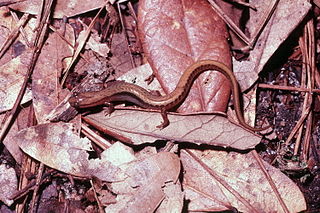
The Asiatic salamanders are primitive salamanders found all over Asia, and in European Russia. They are closely related to the giant salamanders, with which they form the suborder Cryptobranchoidea. About half of hynobiids currently described are unique to Japan.

The alpine salamander is a shiny black salamander found in the central, eastern and Dinaric Alps, at altitudes above 700 m (2,300 ft). The western Alps are inhabited by a similar species, Lanza's alpine salamander, in only one small area. No differences in length are seen between the sexes and the sex ratio is 1:1. Their life expectancy is at least 10 years. Unlike other salamanders, whose larvae are developed in water, the alpine salamander is a fully terrestrial species. Capture-recapture methods suggest that the species is very stationary; 12 m (39 ft) was the maximum observed distance travelled by one individual during the summer season. About 120 individuals per hectare were counted in most suitable areas with >2000 individuals/ha also observed, suggesting that this rather cryptic species is quite abundant.

The long-toed salamander is a mole salamander in the family Ambystomatidae. This species, typically 4.1–8.9 cm (1.6–3.5 in) long when mature, is characterized by its mottled black, brown, and yellow pigmentation, and its long outer fourth toe on the hind limbs. Analysis of fossil records, genetics, and biogeography suggest A. macrodactylum and A. laterale are descended from a common ancestor that gained access to the western Cordillera with the loss of the mid-continental seaway toward the Paleocene.

The four-toed salamander is a lungless salamander native to eastern North America. It is a species of the monotypic genus Hemidactylium.

The striped-faced dunnart(Sminthopsis macroura) is a small, Australian, nocturnal, "marsupial mouse," part of the family Dasyuridae. The species' distribution occurs throughout much of inland central and northern Australia, occupying a range of arid and semi-arid habitats.

The Siberian chipmunk or common chipmunk appears across northern Asia from central Russia to China, Korea, and Hokkaidō in northern Japan. The Siberian chipmunk was imported from South Korea and introduced in Europe as a pet in the 1960s. It is the only chipmunk found outside North America, and this animal is classed either as the only living member of the genus Eutamias, or as a member of a genus including all chipmunks.

The dwarf salamander is a species of salamander native to the southern United States, from North Carolina to Oklahoma, south to Texas along the Gulf of Mexico states to northern Florida. Some sources refer to it as the four-fingered manculus, dwarf four-toed salamander, or the Florida dwarf salamander.

The Japanese giant salamander is endemic to Japan, where it is known as Ōsanshōuo (オオサンショウウオ/大山椒魚), literally meaning "giant pepper fish". With a length of up to almost 1.5 m (5 ft), it is the third-largest salamander in the world, only being surpassed by the very similar and closely related Chinese giant salamander and South China giant salamander. There are currently only five known members of the Cryptobranchidae family: the Japanese, Chinese, and South China giant salamanders, an undescribed Andrias species from eastern China, and the hellbender.

Kushiro-shitsugen National Park is a national park located in the east of the island of Hokkaido, Japan. It was designated as a national park on 31 July 1987. The park is known for its wetlands ecosystems.

The Jeju salamander, also spelled Cheju salamander, is a species of salamander found on various islands and peninsulas off the southwestern coast of the Korean Peninsula, including Jindo, Geojedo, Jejudo, and Namhae. It inhabits moist mountain forests.

Fischer's clawed salamander is a lungless salamander found in Northeast Asia. It ranges through northeastern China, the Russian Far East, and the Korean Peninsula, but is only sporadically distributed within this range. Within South Korea, it is found chiefly in the high mountain valleys of Gangwon province, including the Gwangdeoksan and Daeseongsan regions. The adults feed on spiders, grubs, and insects. It is also known as the long-tailed clawed salamander.
Rana amurensis is a species of true frog found in northern Asia. It ranges across western Siberia, as well as northeastern China, northeastern Mongolia, and on the northern Korean Peninsula and on Sakhalin. Rana coreana was previously included in this species as a subspecies.

The seepage salamander is a small, terrestrial species of salamander in the family Plethodontidae. It is endemic to the United States. They are found in small areas of Tennessee, North Carolina, Georgia, and Alabama. Its natural habitats are temperate forests, intermittent rivers, and freshwater springs. It gets its name from the seepages around which it lives. It is very similar in its appearance and life history to the pygmy salamander. These two species differ greatly from the other Desmognathus species. They are the smallest salamanders in the genus, measuring only 3–5 cm (1–2 in) in length. They are also the only two terrestrial, direct-developing Desmognathus species. However, the two species are not often seen to coexist, differing in distribution by elevation; although there are exceptions. The seepage salamander is currently listed as Near Threatened, with its numbers declining in most of states in which it is found. It is threatened by habitat loss, with logging having a major effect.

Desmognathus fuscus is a species of amphibian in the family Plethodontidae. The species is commonly called the dusky salamander or northern dusky salamander to distinguish it from populations in the southern United States which form a separate species, the southern dusky salamander. The northern dusky salamander is the most widespread representative of its genus in Canada. It can be found in eastern North America from extreme eastern Canada in New Brunswick south into the panhandle of Florida and west to Louisiana. The size of the species' total population is unknown, but is assumed to easily exceed 100,000. The species' habitat differs somewhat geographically; dusky salamanders in the northern part of the range prefer rocky woodland streams, seepages, and springs, while those in the south favor floodplains, sloughs, and muddy places along upland streams. They are most common where water is running or trickling. They hide under various objects, such as leaves or rocks, either in or near water. Alternatively, they may enter burrows for protection. The dusky salamander lays its eggs close to water under moss or rocks, in logs, or in stream-bank cavities. The larval stage which follows is normally aquatic.

The pygmy salamander is a species of salamander in the family Plethodontidae. It is endemic to the United States in the southern Appalachians in North Carolina and Tennessee.

The northern two-lined salamander is a species of salamander in the family Plethodontidae found in Canada and the United States. Its natural habitats are temperate forests, temperate shrubland, rivers, intermittent rivers, freshwater marshes, freshwater springs, arable land, and urban areas. It is more water-oriented than the related northern redback salamander, and can often be found in and around water such as rain puddles, streams, swamps, and damp stream beds, whereas the northern redback tends to be found in damp ground, but usually not near open water.
Ixalotriton parva, the dwarf false brook salamander, is a species of salamander in the family Plethodontidae. It is endemic to a small mountainous area of Mexico where its natural habitat is subtropical or tropical moist montane forests. It is threatened by habitat loss. There is some doubt whether this species should be classified as Pseudoeurycea parva or Ixalotriton parva.

The southern torrent salamander is a member of the salamander family Rhyacotritonidae. This species of torrent salamander is found the farthest south in the region. It is a small salamander endemic to the Pacific Northwest from Northern California to Northern Oregon. It is one of four species of Rhyacotriton, along with R. cascadae, R. kezeri and R. olympicus. All species of Rhyacotriton are small, with their body lengths being less than 5 inches. The species reproduces annually, with an extended courtship and egg-laying period. The time it takes from oviposition to reach sexual maturity ranges from five to eight years, making the generation interval rather long. The larval stage, from hatching to metamorphosis, lasts 2.0-2.5 yr, with females requiring another 1.5–2.0 yr until they can first breed. They reach sexual maturity 1.0-1.5 yr after metamorphosis which occurs between 4.5 and 5.0 yr. This species feeds on small insects and spiders. Although it is found over a large area, it is not a migratory creature. It is preyed on by Pacific giant salamanders and garter snakes.





















